Accounting for Business: Financial Analysis and Investment Decisions
VerifiedAdded on 2023/06/17
|12
|1463
|280
Report
AI Summary
This accounting report provides a detailed analysis of financial statements, investment appraisal techniques, and break-even analysis. It begins with the preparation of an income statement and statement of financial position based on provided data. The report then evaluates a project's financial viability using payback period and net present value (NPV) calculations, advising on the project's feasibility based on these metrics. It also discusses non-financial factors that should be considered in investment decisions and comments on the internal rate of return (IRR). Furthermore, the report calculates break-even points under different scenarios, evaluating the profitability and BEP units for various proposals, and discusses the limitations of break-even analysis. Desklib offers a wealth of similar solved assignments and past papers to aid students in their studies.
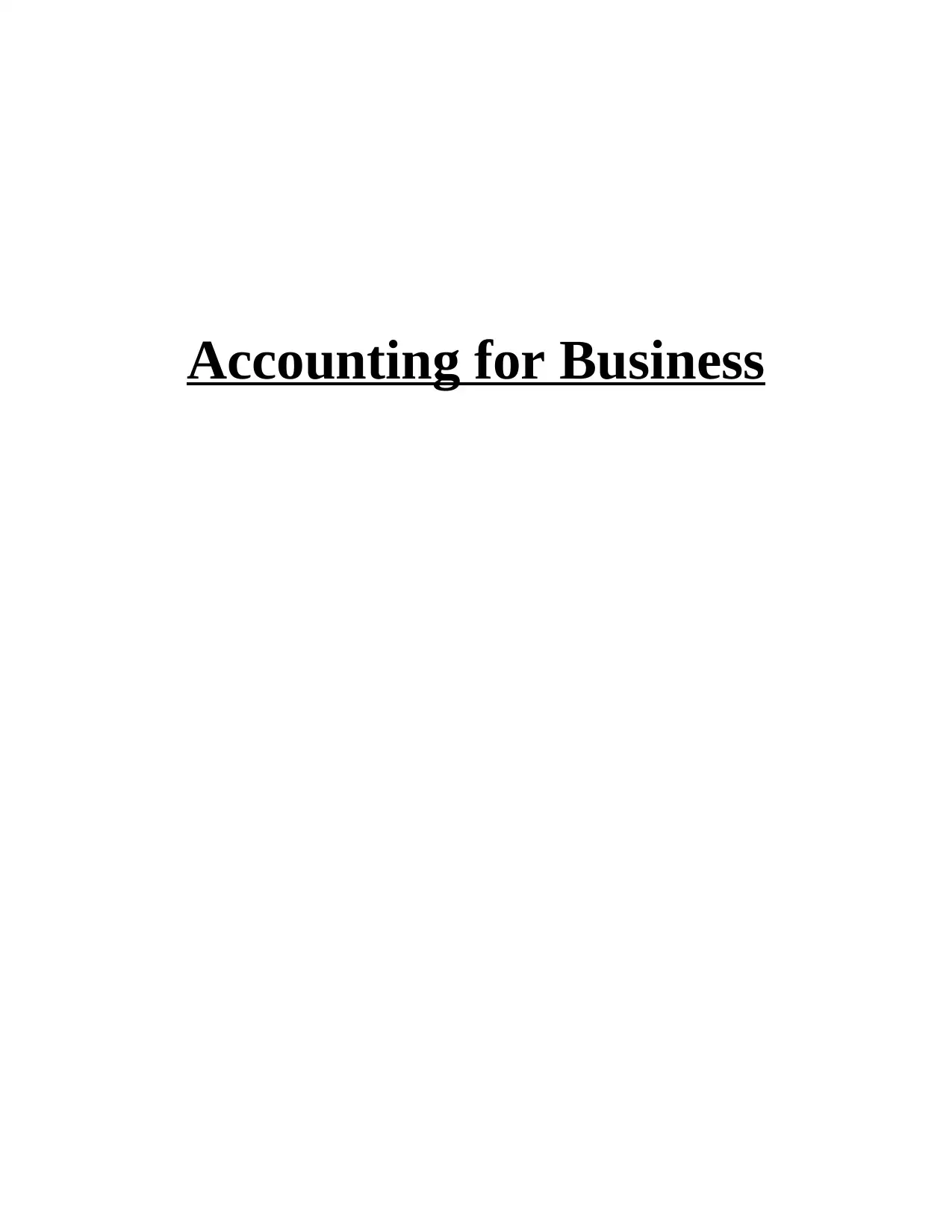
Accounting for Business
Paraphrase This Document
Need a fresh take? Get an instant paraphrase of this document with our AI Paraphraser
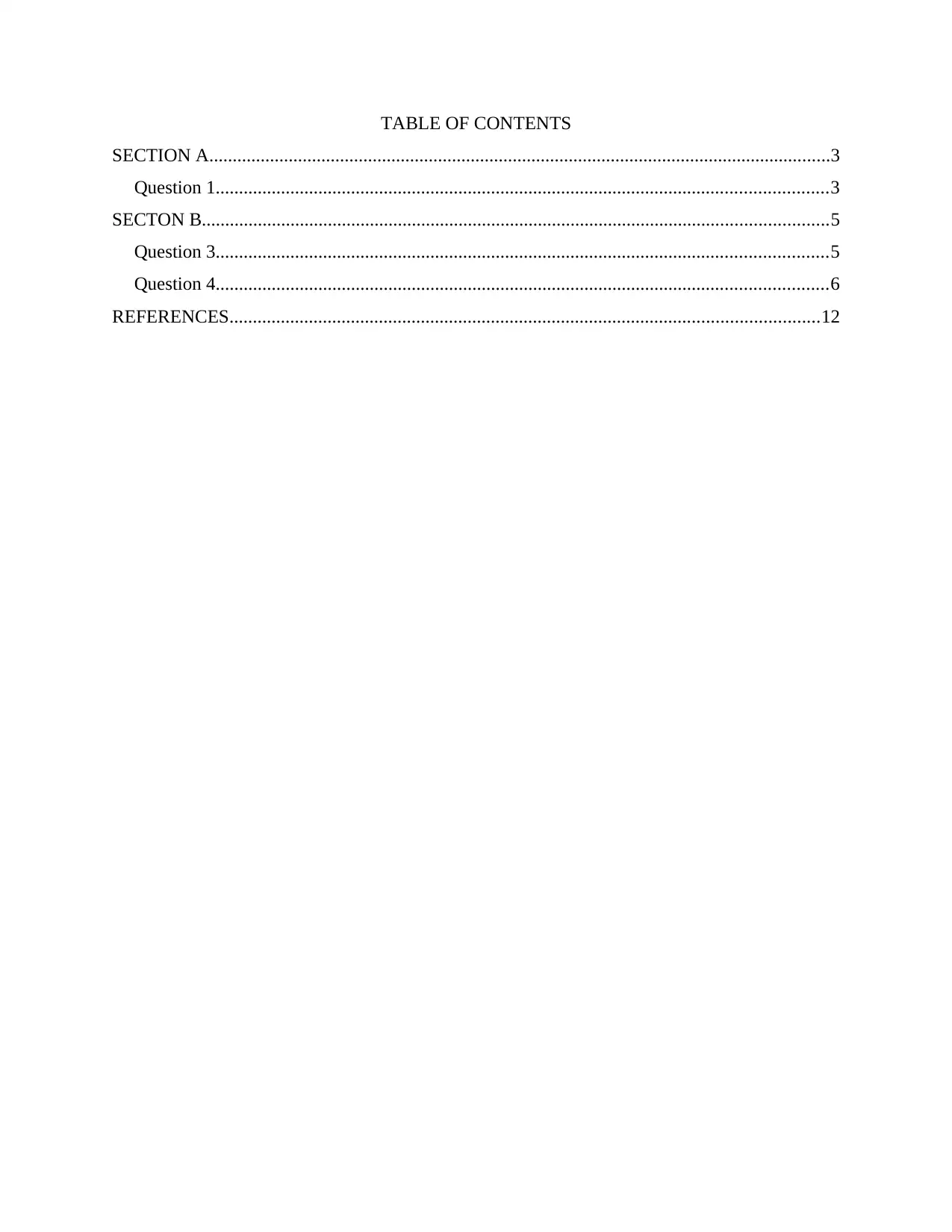
TABLE OF CONTENTS
SECTION A.....................................................................................................................................3
Question 1...................................................................................................................................3
SECTON B......................................................................................................................................5
Question 3...................................................................................................................................5
Question 4...................................................................................................................................6
REFERENCES..............................................................................................................................12
SECTION A.....................................................................................................................................3
Question 1...................................................................................................................................3
SECTON B......................................................................................................................................5
Question 3...................................................................................................................................5
Question 4...................................................................................................................................6
REFERENCES..............................................................................................................................12
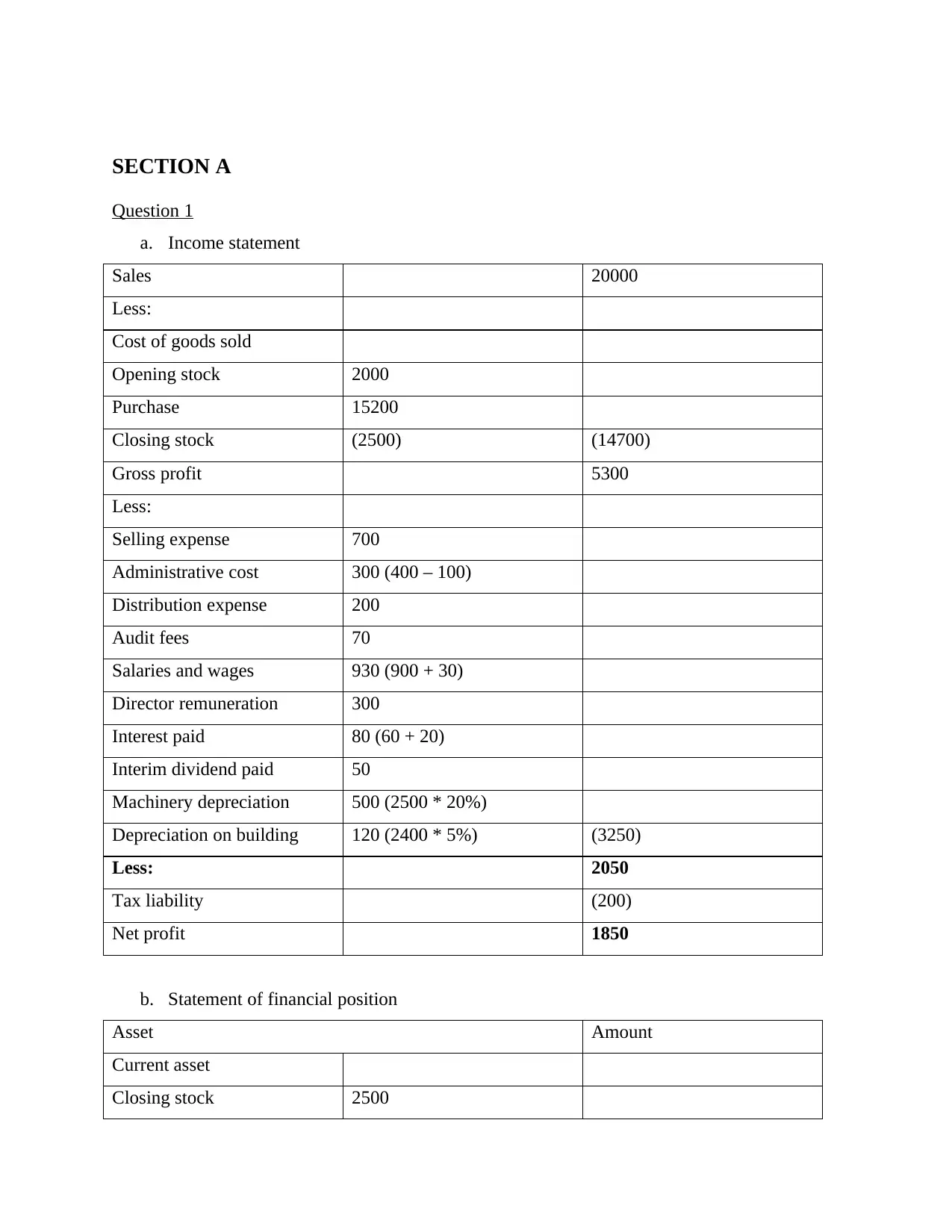
SECTION A
Question 1
a. Income statement
Sales 20000
Less:
Cost of goods sold
Opening stock 2000
Purchase 15200
Closing stock (2500) (14700)
Gross profit 5300
Less:
Selling expense 700
Administrative cost 300 (400 – 100)
Distribution expense 200
Audit fees 70
Salaries and wages 930 (900 + 30)
Director remuneration 300
Interest paid 80 (60 + 20)
Interim dividend paid 50
Machinery depreciation 500 (2500 * 20%)
Depreciation on building 120 (2400 * 5%) (3250)
Less: 2050
Tax liability (200)
Net profit 1850
b. Statement of financial position
Asset Amount
Current asset
Closing stock 2500
Question 1
a. Income statement
Sales 20000
Less:
Cost of goods sold
Opening stock 2000
Purchase 15200
Closing stock (2500) (14700)
Gross profit 5300
Less:
Selling expense 700
Administrative cost 300 (400 – 100)
Distribution expense 200
Audit fees 70
Salaries and wages 930 (900 + 30)
Director remuneration 300
Interest paid 80 (60 + 20)
Interim dividend paid 50
Machinery depreciation 500 (2500 * 20%)
Depreciation on building 120 (2400 * 5%) (3250)
Less: 2050
Tax liability (200)
Net profit 1850
b. Statement of financial position
Asset Amount
Current asset
Closing stock 2500
⊘ This is a preview!⊘
Do you want full access?
Subscribe today to unlock all pages.

Trusted by 1+ million students worldwide
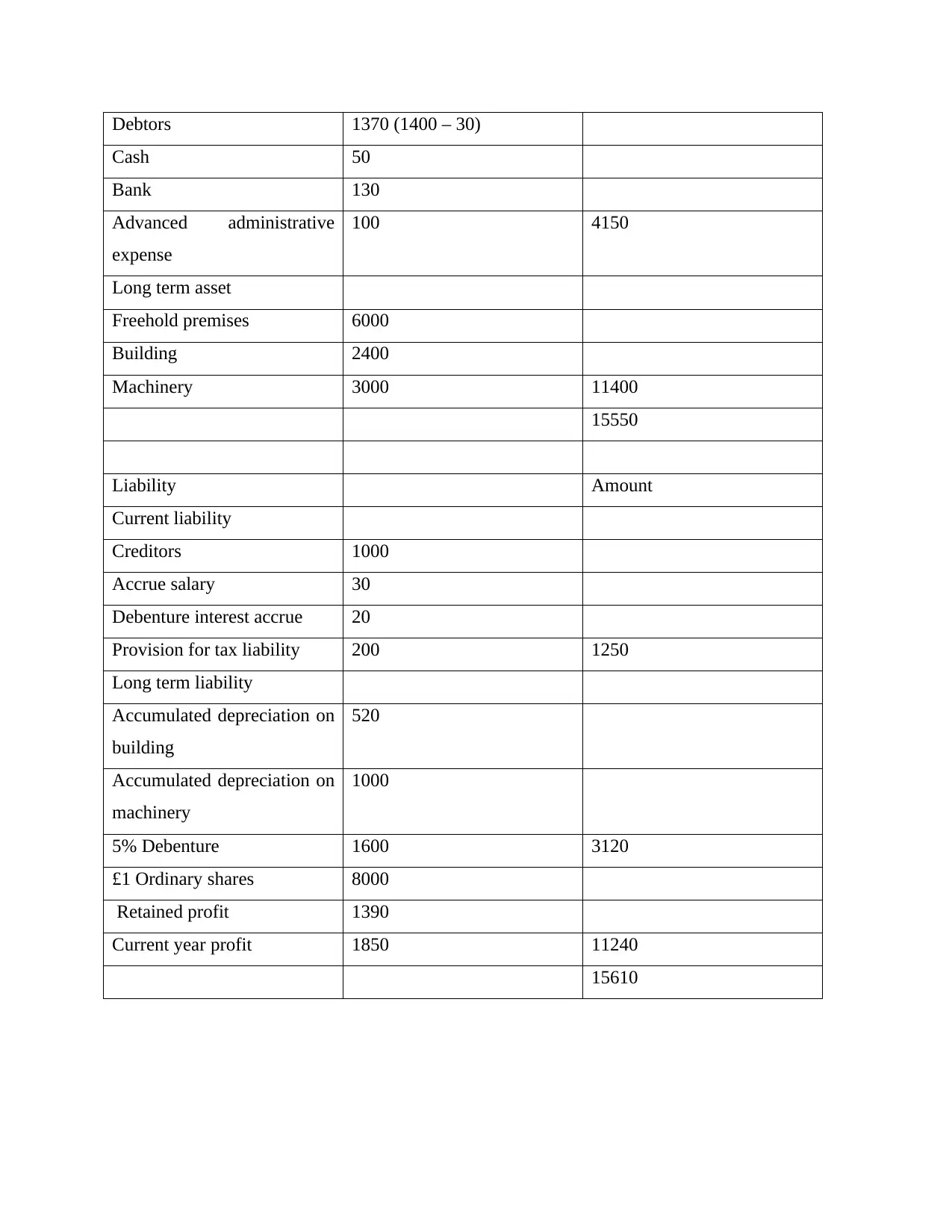
Debtors 1370 (1400 – 30)
Cash 50
Bank 130
Advanced administrative
expense
100 4150
Long term asset
Freehold premises 6000
Building 2400
Machinery 3000 11400
15550
Liability Amount
Current liability
Creditors 1000
Accrue salary 30
Debenture interest accrue 20
Provision for tax liability 200 1250
Long term liability
Accumulated depreciation on
building
520
Accumulated depreciation on
machinery
1000
5% Debenture 1600 3120
£1 Ordinary shares 8000
Retained profit 1390
Current year profit 1850 11240
15610
Cash 50
Bank 130
Advanced administrative
expense
100 4150
Long term asset
Freehold premises 6000
Building 2400
Machinery 3000 11400
15550
Liability Amount
Current liability
Creditors 1000
Accrue salary 30
Debenture interest accrue 20
Provision for tax liability 200 1250
Long term liability
Accumulated depreciation on
building
520
Accumulated depreciation on
machinery
1000
5% Debenture 1600 3120
£1 Ordinary shares 8000
Retained profit 1390
Current year profit 1850 11240
15610
Paraphrase This Document
Need a fresh take? Get an instant paraphrase of this document with our AI Paraphraser

SECTON B
Question 3
Payback period
Year Cash inflows Cumulative cash inflows
1 600000 600000
2 700000 1300000
3 800000 2100000
4 500000 2600000
5 200000 2800000
6 300000 3100000
Initial investment 2000000
Payback period 0.9
Payback period 2 year and 9 months
Net present value
Computation of NPV
Year Cash inflows PV factor @ 10 %
Discounted
cash inflows
1 600000 0.909 545454.5455
2 700000 0.826 578512.3967
3 800000 0.751 601051.8407
4 500000 0.683 341506.7277
5 200000 0.621 124184.2646
6 300000 0.564 169342.179
Total discounted cash inflow 2360052
Initial investment 2000000
NPV (Total discounted cash
inflows - initial investment) 360052
Advising on financial viability of project
On the basis of the above calculation it is clear that the financial viability of J ltd project
of investment decision relating to new product introduction is good. The reason pertaining to the
factors that both NPV and payback period are good for the company (Alles and et.al., 2021). The
Question 3
Payback period
Year Cash inflows Cumulative cash inflows
1 600000 600000
2 700000 1300000
3 800000 2100000
4 500000 2600000
5 200000 2800000
6 300000 3100000
Initial investment 2000000
Payback period 0.9
Payback period 2 year and 9 months
Net present value
Computation of NPV
Year Cash inflows PV factor @ 10 %
Discounted
cash inflows
1 600000 0.909 545454.5455
2 700000 0.826 578512.3967
3 800000 0.751 601051.8407
4 500000 0.683 341506.7277
5 200000 0.621 124184.2646
6 300000 0.564 169342.179
Total discounted cash inflow 2360052
Initial investment 2000000
NPV (Total discounted cash
inflows - initial investment) 360052
Advising on financial viability of project
On the basis of the above calculation it is clear that the financial viability of J ltd project
of investment decision relating to new product introduction is good. The reason pertaining to the
factors that both NPV and payback period are good for the company (Alles and et.al., 2021). The
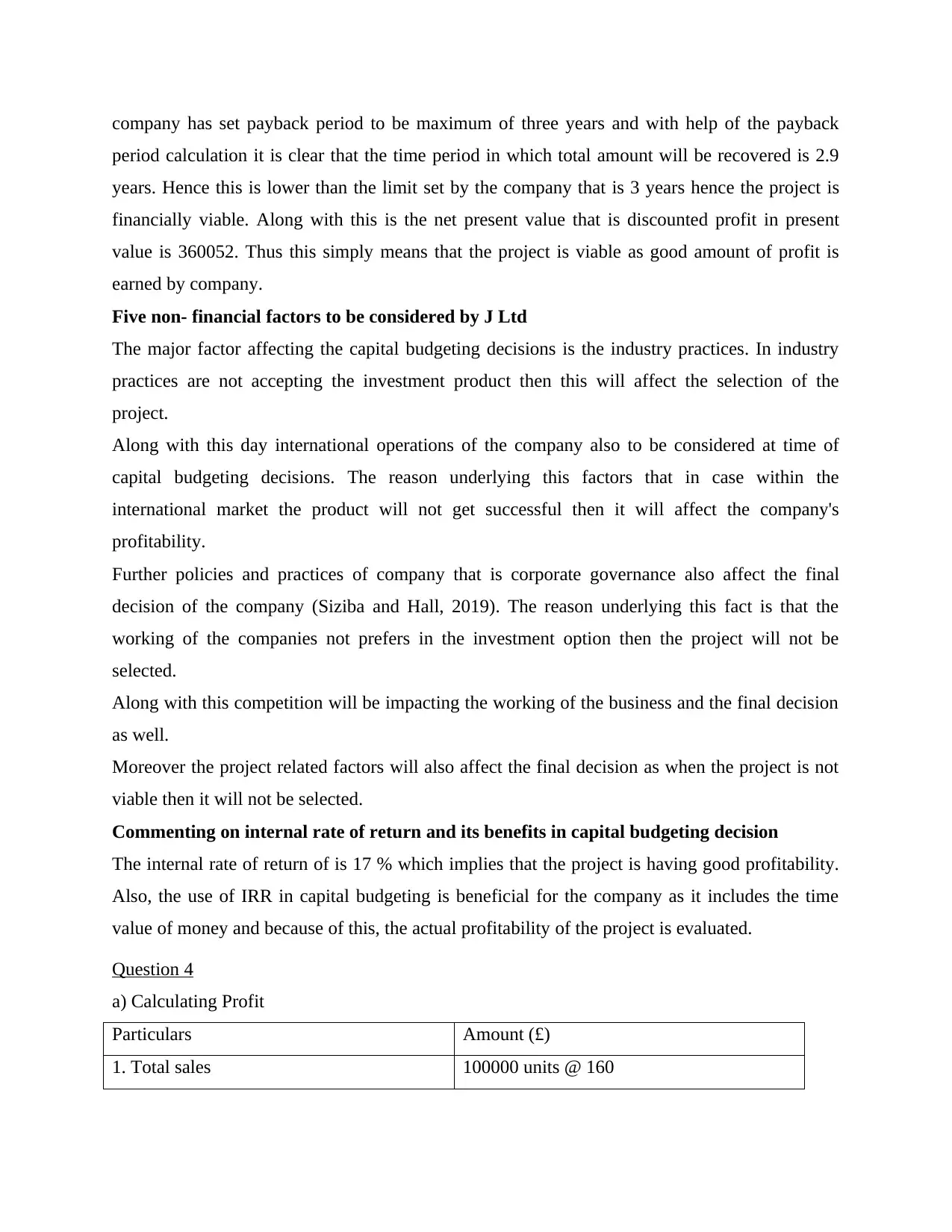
company has set payback period to be maximum of three years and with help of the payback
period calculation it is clear that the time period in which total amount will be recovered is 2.9
years. Hence this is lower than the limit set by the company that is 3 years hence the project is
financially viable. Along with this is the net present value that is discounted profit in present
value is 360052. Thus this simply means that the project is viable as good amount of profit is
earned by company.
Five non- financial factors to be considered by J Ltd
The major factor affecting the capital budgeting decisions is the industry practices. In industry
practices are not accepting the investment product then this will affect the selection of the
project.
Along with this day international operations of the company also to be considered at time of
capital budgeting decisions. The reason underlying this factors that in case within the
international market the product will not get successful then it will affect the company's
profitability.
Further policies and practices of company that is corporate governance also affect the final
decision of the company (Siziba and Hall, 2019). The reason underlying this fact is that the
working of the companies not prefers in the investment option then the project will not be
selected.
Along with this competition will be impacting the working of the business and the final decision
as well.
Moreover the project related factors will also affect the final decision as when the project is not
viable then it will not be selected.
Commenting on internal rate of return and its benefits in capital budgeting decision
The internal rate of return of is 17 % which implies that the project is having good profitability.
Also, the use of IRR in capital budgeting is beneficial for the company as it includes the time
value of money and because of this, the actual profitability of the project is evaluated.
Question 4
a) Calculating Profit
Particulars Amount (£)
1. Total sales 100000 units @ 160
period calculation it is clear that the time period in which total amount will be recovered is 2.9
years. Hence this is lower than the limit set by the company that is 3 years hence the project is
financially viable. Along with this is the net present value that is discounted profit in present
value is 360052. Thus this simply means that the project is viable as good amount of profit is
earned by company.
Five non- financial factors to be considered by J Ltd
The major factor affecting the capital budgeting decisions is the industry practices. In industry
practices are not accepting the investment product then this will affect the selection of the
project.
Along with this day international operations of the company also to be considered at time of
capital budgeting decisions. The reason underlying this factors that in case within the
international market the product will not get successful then it will affect the company's
profitability.
Further policies and practices of company that is corporate governance also affect the final
decision of the company (Siziba and Hall, 2019). The reason underlying this fact is that the
working of the companies not prefers in the investment option then the project will not be
selected.
Along with this competition will be impacting the working of the business and the final decision
as well.
Moreover the project related factors will also affect the final decision as when the project is not
viable then it will not be selected.
Commenting on internal rate of return and its benefits in capital budgeting decision
The internal rate of return of is 17 % which implies that the project is having good profitability.
Also, the use of IRR in capital budgeting is beneficial for the company as it includes the time
value of money and because of this, the actual profitability of the project is evaluated.
Question 4
a) Calculating Profit
Particulars Amount (£)
1. Total sales 100000 units @ 160
⊘ This is a preview!⊘
Do you want full access?
Subscribe today to unlock all pages.

Trusted by 1+ million students worldwide
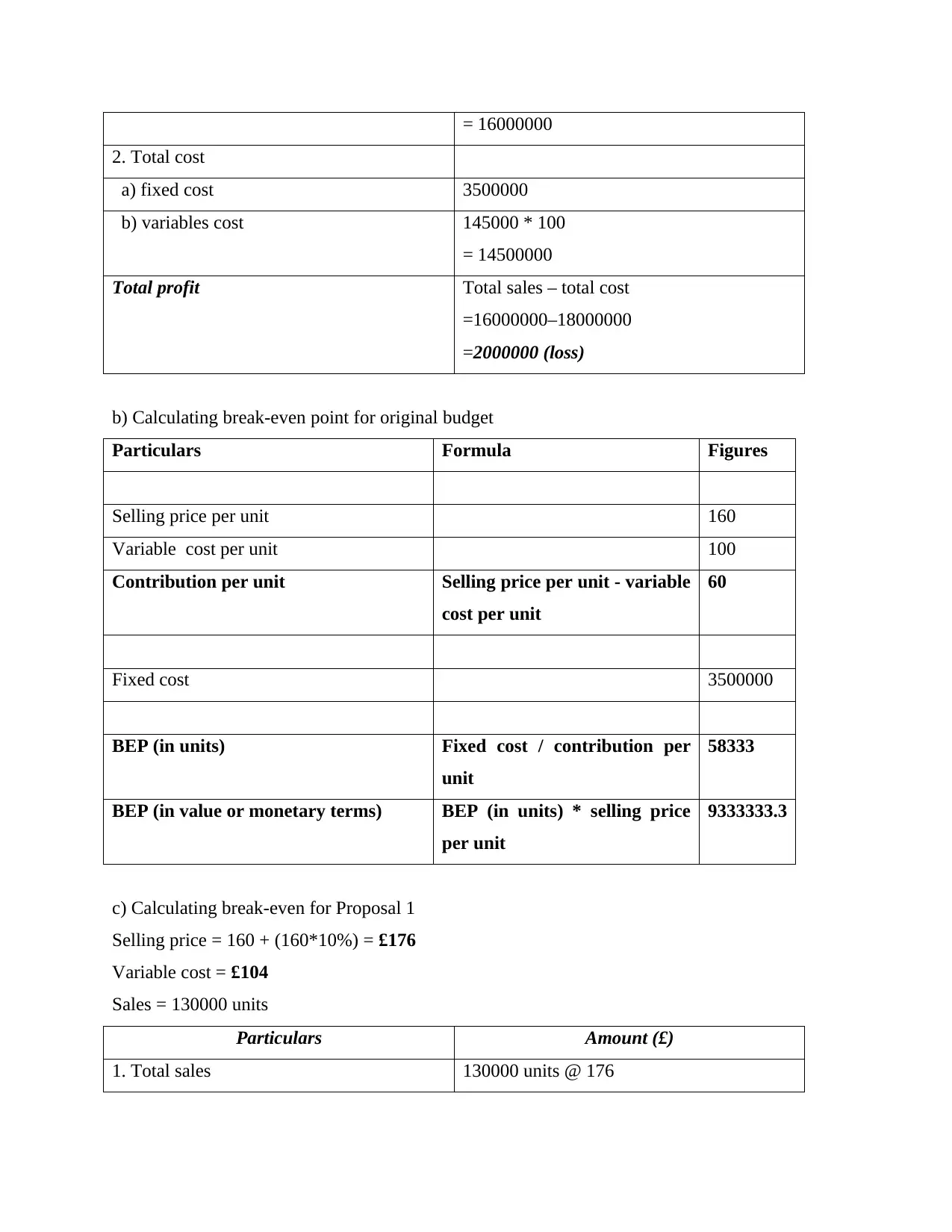
= 16000000
2. Total cost
a) fixed cost 3500000
b) variables cost 145000 * 100
= 14500000
Total profit Total sales – total cost
=16000000–18000000
=2000000 (loss)
b) Calculating break-even point for original budget
Particulars Formula Figures
Selling price per unit 160
Variable cost per unit 100
Contribution per unit Selling price per unit - variable
cost per unit
60
Fixed cost 3500000
BEP (in units) Fixed cost / contribution per
unit
58333
BEP (in value or monetary terms) BEP (in units) * selling price
per unit
9333333.3
c) Calculating break-even for Proposal 1
Selling price = 160 + (160*10%) = £176
Variable cost = £104
Sales = 130000 units
Particulars Amount (£)
1. Total sales 130000 units @ 176
2. Total cost
a) fixed cost 3500000
b) variables cost 145000 * 100
= 14500000
Total profit Total sales – total cost
=16000000–18000000
=2000000 (loss)
b) Calculating break-even point for original budget
Particulars Formula Figures
Selling price per unit 160
Variable cost per unit 100
Contribution per unit Selling price per unit - variable
cost per unit
60
Fixed cost 3500000
BEP (in units) Fixed cost / contribution per
unit
58333
BEP (in value or monetary terms) BEP (in units) * selling price
per unit
9333333.3
c) Calculating break-even for Proposal 1
Selling price = 160 + (160*10%) = £176
Variable cost = £104
Sales = 130000 units
Particulars Amount (£)
1. Total sales 130000 units @ 176
Paraphrase This Document
Need a fresh take? Get an instant paraphrase of this document with our AI Paraphraser
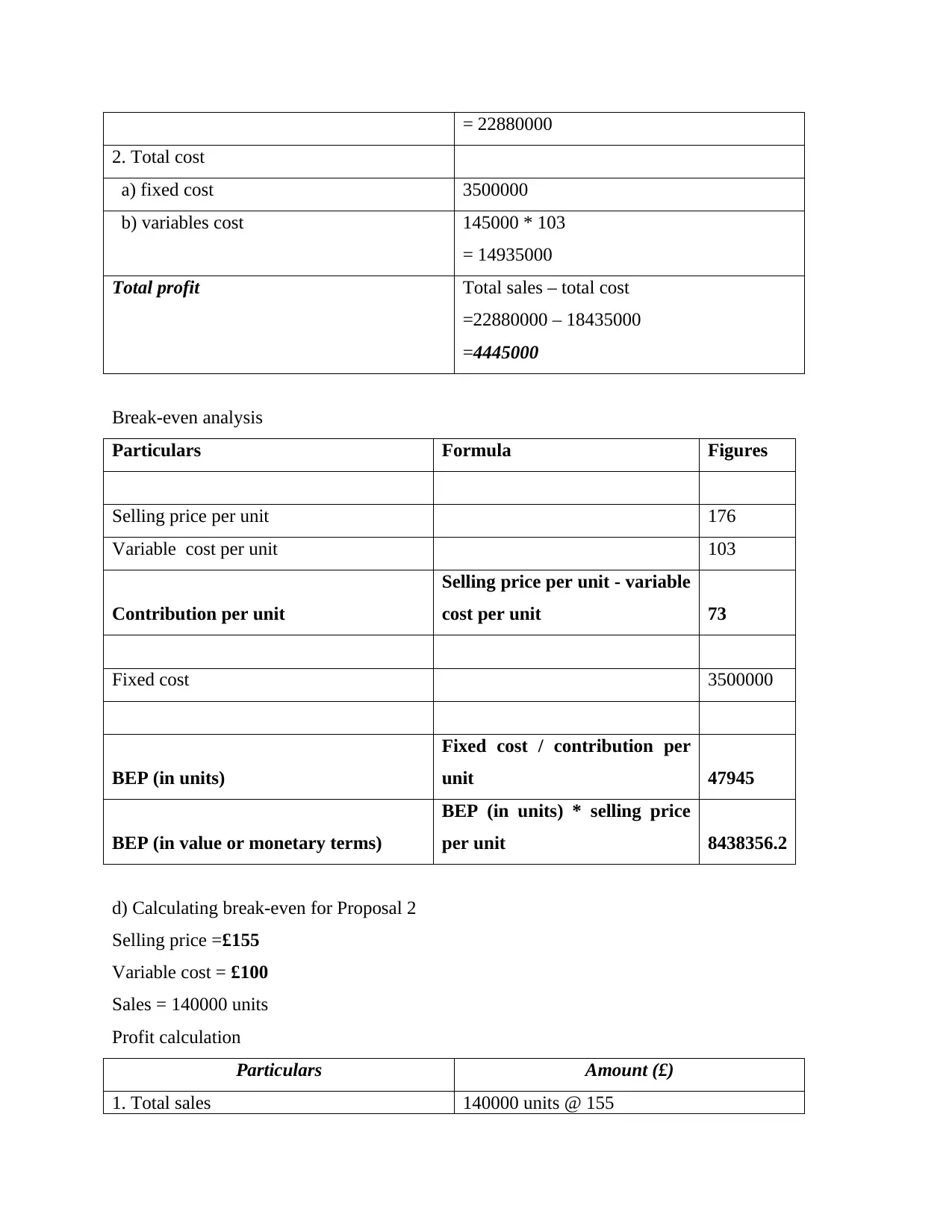
= 22880000
2. Total cost
a) fixed cost 3500000
b) variables cost 145000 * 103
= 14935000
Total profit Total sales – total cost
=22880000 – 18435000
=4445000
Break-even analysis
Particulars Formula Figures
Selling price per unit 176
Variable cost per unit 103
Contribution per unit
Selling price per unit - variable
cost per unit 73
Fixed cost 3500000
BEP (in units)
Fixed cost / contribution per
unit 47945
BEP (in value or monetary terms)
BEP (in units) * selling price
per unit 8438356.2
d) Calculating break-even for Proposal 2
Selling price =£155
Variable cost = £100
Sales = 140000 units
Profit calculation
Particulars Amount (£)
1. Total sales 140000 units @ 155
2. Total cost
a) fixed cost 3500000
b) variables cost 145000 * 103
= 14935000
Total profit Total sales – total cost
=22880000 – 18435000
=4445000
Break-even analysis
Particulars Formula Figures
Selling price per unit 176
Variable cost per unit 103
Contribution per unit
Selling price per unit - variable
cost per unit 73
Fixed cost 3500000
BEP (in units)
Fixed cost / contribution per
unit 47945
BEP (in value or monetary terms)
BEP (in units) * selling price
per unit 8438356.2
d) Calculating break-even for Proposal 2
Selling price =£155
Variable cost = £100
Sales = 140000 units
Profit calculation
Particulars Amount (£)
1. Total sales 140000 units @ 155
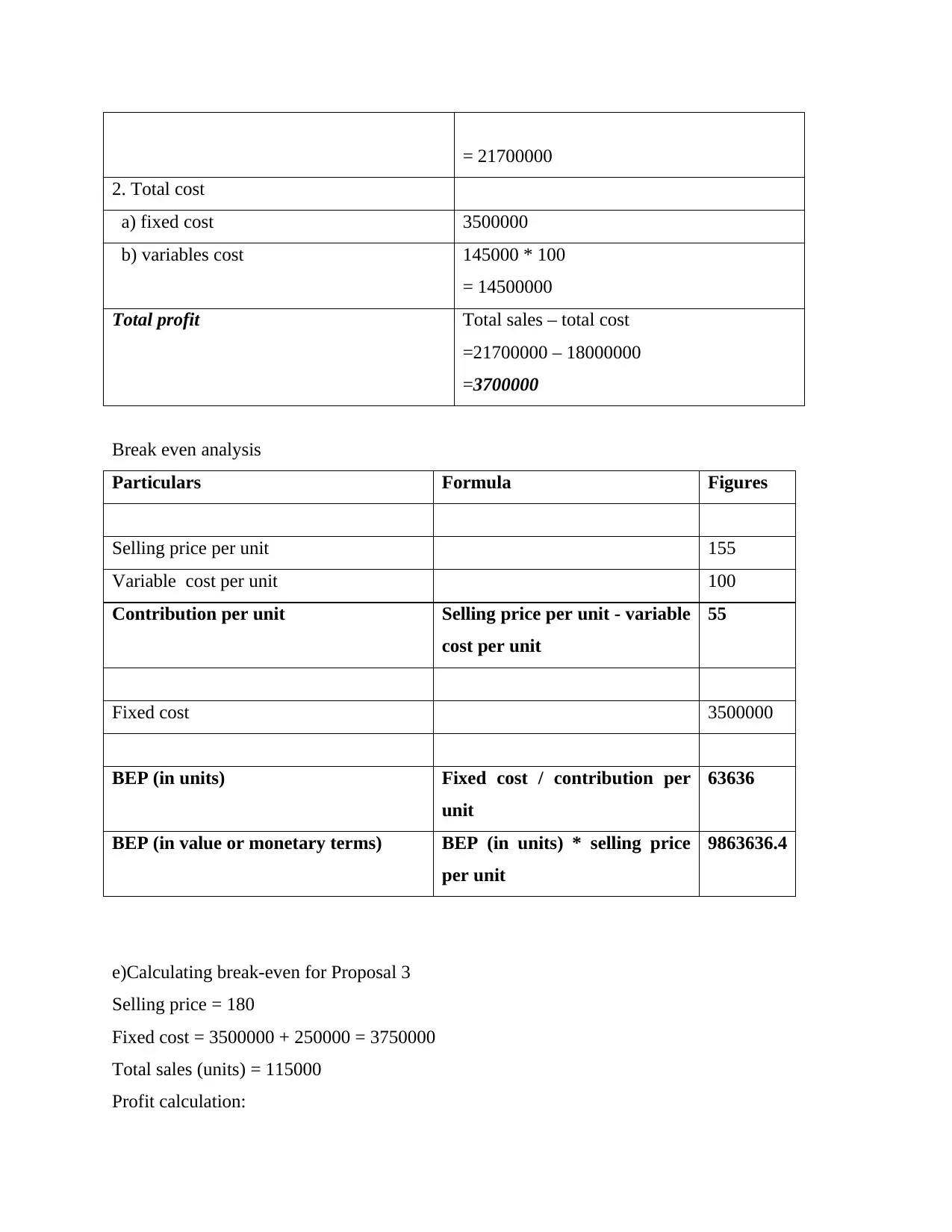
= 21700000
2. Total cost
a) fixed cost 3500000
b) variables cost 145000 * 100
= 14500000
Total profit Total sales – total cost
=21700000 – 18000000
=3700000
Break even analysis
Particulars Formula Figures
Selling price per unit 155
Variable cost per unit 100
Contribution per unit Selling price per unit - variable
cost per unit
55
Fixed cost 3500000
BEP (in units) Fixed cost / contribution per
unit
63636
BEP (in value or monetary terms) BEP (in units) * selling price
per unit
9863636.4
e)Calculating break-even for Proposal 3
Selling price = 180
Fixed cost = 3500000 + 250000 = 3750000
Total sales (units) = 115000
Profit calculation:
2. Total cost
a) fixed cost 3500000
b) variables cost 145000 * 100
= 14500000
Total profit Total sales – total cost
=21700000 – 18000000
=3700000
Break even analysis
Particulars Formula Figures
Selling price per unit 155
Variable cost per unit 100
Contribution per unit Selling price per unit - variable
cost per unit
55
Fixed cost 3500000
BEP (in units) Fixed cost / contribution per
unit
63636
BEP (in value or monetary terms) BEP (in units) * selling price
per unit
9863636.4
e)Calculating break-even for Proposal 3
Selling price = 180
Fixed cost = 3500000 + 250000 = 3750000
Total sales (units) = 115000
Profit calculation:
⊘ This is a preview!⊘
Do you want full access?
Subscribe today to unlock all pages.

Trusted by 1+ million students worldwide
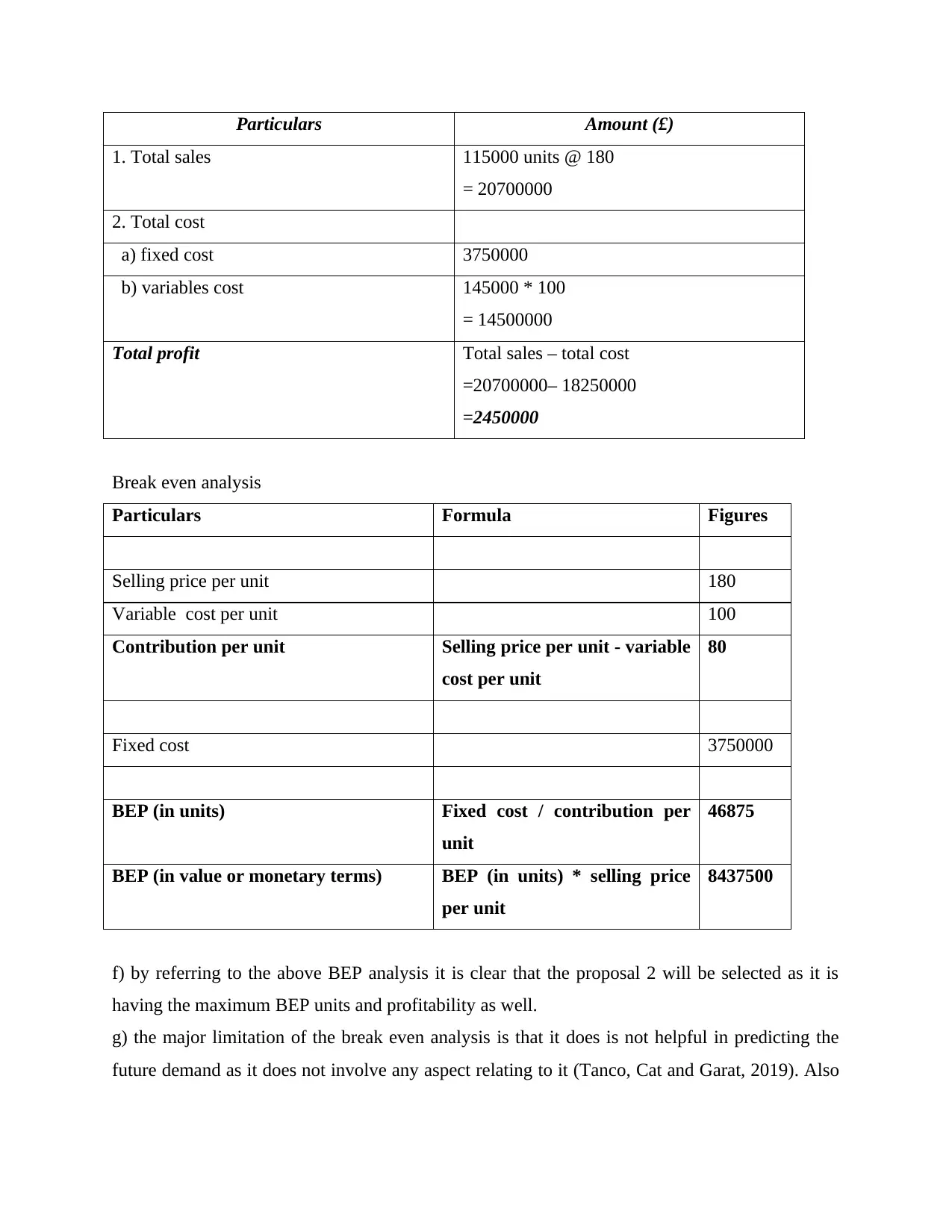
Particulars Amount (£)
1. Total sales 115000 units @ 180
= 20700000
2. Total cost
a) fixed cost 3750000
b) variables cost 145000 * 100
= 14500000
Total profit Total sales – total cost
=20700000– 18250000
=2450000
Break even analysis
Particulars Formula Figures
Selling price per unit 180
Variable cost per unit 100
Contribution per unit Selling price per unit - variable
cost per unit
80
Fixed cost 3750000
BEP (in units) Fixed cost / contribution per
unit
46875
BEP (in value or monetary terms) BEP (in units) * selling price
per unit
8437500
f) by referring to the above BEP analysis it is clear that the proposal 2 will be selected as it is
having the maximum BEP units and profitability as well.
g) the major limitation of the break even analysis is that it does is not helpful in predicting the
future demand as it does not involve any aspect relating to it (Tanco, Cat and Garat, 2019). Also
1. Total sales 115000 units @ 180
= 20700000
2. Total cost
a) fixed cost 3750000
b) variables cost 145000 * 100
= 14500000
Total profit Total sales – total cost
=20700000– 18250000
=2450000
Break even analysis
Particulars Formula Figures
Selling price per unit 180
Variable cost per unit 100
Contribution per unit Selling price per unit - variable
cost per unit
80
Fixed cost 3750000
BEP (in units) Fixed cost / contribution per
unit
46875
BEP (in value or monetary terms) BEP (in units) * selling price
per unit
8437500
f) by referring to the above BEP analysis it is clear that the proposal 2 will be selected as it is
having the maximum BEP units and profitability as well.
g) the major limitation of the break even analysis is that it does is not helpful in predicting the
future demand as it does not involve any aspect relating to it (Tanco, Cat and Garat, 2019). Also
Paraphrase This Document
Need a fresh take? Get an instant paraphrase of this document with our AI Paraphraser
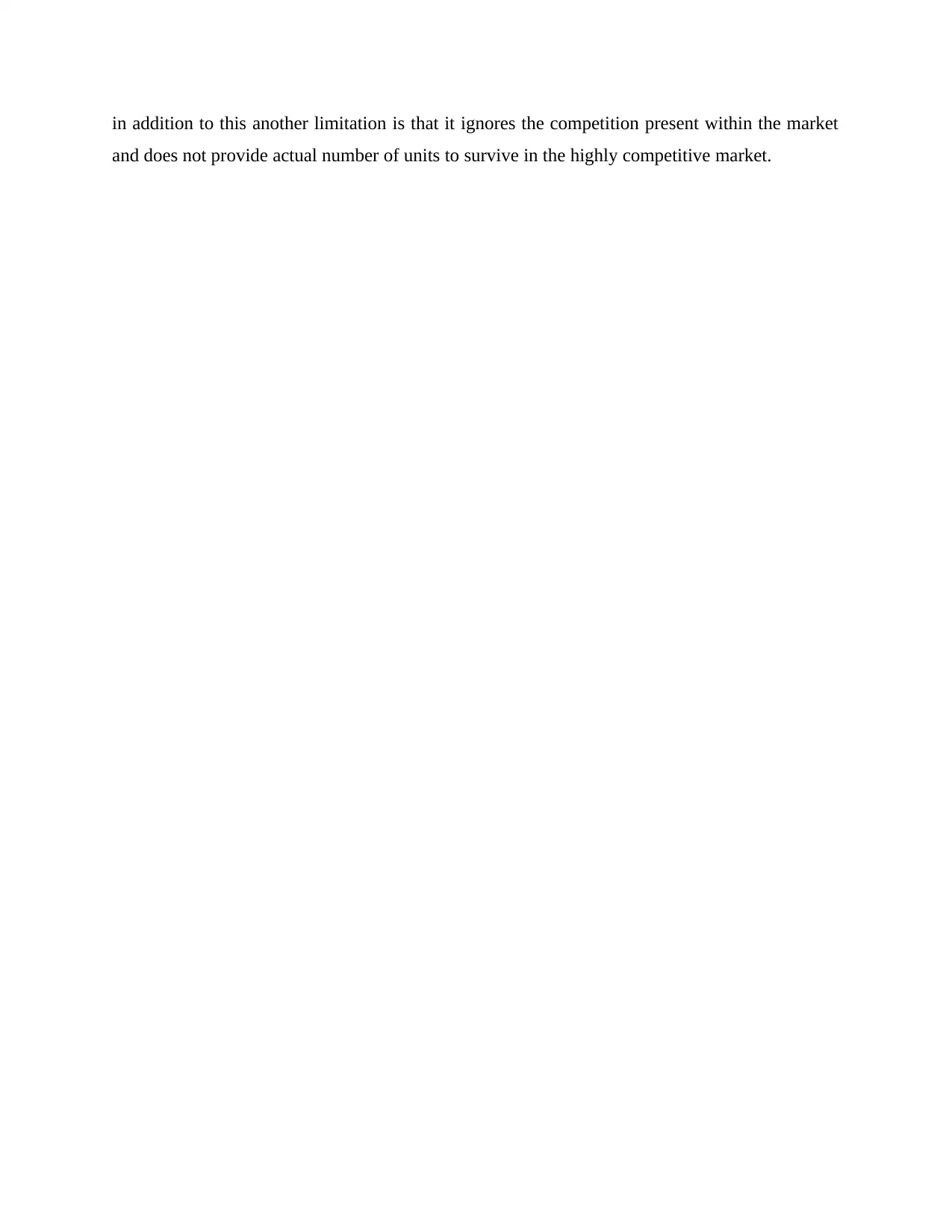
in addition to this another limitation is that it ignores the competition present within the market
and does not provide actual number of units to survive in the highly competitive market.
and does not provide actual number of units to survive in the highly competitive market.

REFERENCES
Books and Journals
Tanco, M., Cat, L. and Garat, S., 2019. A break-even analysis for battery electric trucks in Latin
America. Journal of Cleaner Production, 228, pp.1354-1367.
Siziba, S. and Hall, J.H., 2019. The evolution of the application of capital budgeting techniques
in enterprises. Global Finance Journal, p.100504.
Alles, L., and et.al., 2021. An investigation of the usage of capital budgeting techniques by small
and medium enterprises. Quality & Quantity, 55(3), pp.993-1006.
Books and Journals
Tanco, M., Cat, L. and Garat, S., 2019. A break-even analysis for battery electric trucks in Latin
America. Journal of Cleaner Production, 228, pp.1354-1367.
Siziba, S. and Hall, J.H., 2019. The evolution of the application of capital budgeting techniques
in enterprises. Global Finance Journal, p.100504.
Alles, L., and et.al., 2021. An investigation of the usage of capital budgeting techniques by small
and medium enterprises. Quality & Quantity, 55(3), pp.993-1006.
⊘ This is a preview!⊘
Do you want full access?
Subscribe today to unlock all pages.

Trusted by 1+ million students worldwide
1 out of 12
Related Documents
Your All-in-One AI-Powered Toolkit for Academic Success.
+13062052269
info@desklib.com
Available 24*7 on WhatsApp / Email
![[object Object]](/_next/static/media/star-bottom.7253800d.svg)
Unlock your academic potential
Copyright © 2020–2025 A2Z Services. All Rights Reserved. Developed and managed by ZUCOL.



